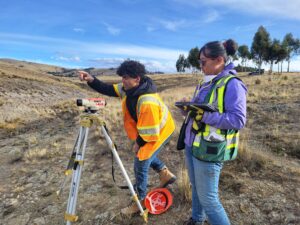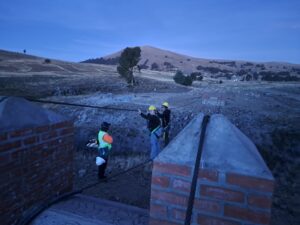U of T Engineers in Action (EIA) students team up to connect separated communities in rural Bolivia.

Solving real-world problems is a worthy goal for any student looking to become an engineer, but usually something envisioned as only possible after graduation. The chance to get involved in a real hands-on project in another country, with the ability to have a substantial and immediate impact on the lives of an entire community, is one some of our very own CivMin students got to fulfill this spring.
U of T Engineering students from the all-volunteer group Engineers in Action (EIA) have once more completed a bridge-building project for a community in need. The EIA U of T Student Chapter joined forces with their counterparts at the University of Alberta (U of A EIA) to successfully design and build a suspended footbridge linking the rural residents near the Suraj Mayu community in Bolivia [ED NOTE: the bridge is visible in the satellite view].

The interdisciplinary group, including students from several U of T Engineering departments, combined their skills with guidance and support from Arup and faculty advisor Prof. Brent Sleep.
Luna Amador (CivE 2T2 + PEY), Co-President of EIA U of T Chapter, offers up the on-the-ground perspective, “It’s neat to see, when you look at the maps or even the satellite views, you realize just how rugged the terrain is and how isolated they are. If they want to go a that short distance across the other side, it’s quite an extraordinary journey to make. By building this bridge, you really get to help this community come together more easily.”

This year’s project, completed this past May, is located near the Suraj Mayu community, in the department of Cochabamba in Bolivia. It is isolated by the presence of a river within a ravine. The bridge spans over the Suraj Mayu River, which is usually impassable for nearly half the year – from October to March – due to heavy rainfall. The completion of this footbridge alleviates the community’s isolation, providing them with reliable and safe access to essential services, such as school, healthcare, and economic opportunities.
For the seventh consecutive year, Engineers in Action (EIA) University of Toronto Student Chapter partnered with Arup to help deliver a pedestrian footbridge in a remote Bolivian community.
The U of T group received the guidance of Senior Engineer in Bridges and Civil Structures at Arup, Maxime Bellefeuille who is based in Montreal, along with several of his colleagues. A total of five working engineers were providing valuable insight and feedback, including Felice Lam (Toronto), Jorge Cobo (Chicago), Mark Fisher (San Francisco) and Casie Venable (San Francisco).

Bellefeuille has a history with assisting the U of T EIA team, “A co-worker of mine, who used to work in Toronto, knew I had been involved with Bridge to Prosperity in the past, so he forwarded me the details and I got interested, so I started helping out on the first-year’s project. Then it bloomed into what we have now – a seven-year partnership.”
With Arup’s assistance, the team received mentorship, advice and reviews of the University team’s formal reports, so they could complete their design package by April 2023, including project planning, design development and construction plans. With the help of the local community, the bridge was successfully completed and inaugurated a week ahead of schedule.

Besides engineering and technical expertise, there are contracts, logistics and more to look after. “Prof. Sleep helped us navigate agreements and contracts so we could help EIA and Arup come to agreements on various points. It was very helpful to have him navigate this for us,” says Amador. “We’ve gone through quite a process to plan, then build, but it’s so satisfying to see the community get this bridge with an expected lifespan of 25 years or more. So it’s a long-lasting impact we’ve made.”


Recalling the satisfaction of completing the build, Amador offers, “Overall, 950 inhabitants of the area will now benefit from the bridge, out of the total population of 1,100 in the area. Another fun detail of our stay is the community housed our team in a large classroom in the school. During construction we would sleep and relax there after the work day.”
The successful completion of the footbridge project exemplifies the positive impact the EIA U of T Student Chapter, along with the support of Arup, can have on isolated communities. The successful project not only provided improved access to essential services but also strengthened community bonds and resilience. This year’s project marks the first time the U of T team travelled to site since the COVID pandemic.
By Phill Snel
Last year’s project (2022) involved a build near Quinamara, Bolivia.
EIA U of T has a an upcoming Bridge Building Competition on Saturday, October 7, 2023. The registration due date is Wednesday, October 4, 2023. If registration has passed, but you would like to attend, please contact the event organizer, Hoda via email at hoda.eissa@mail.utoronto.ca
Engineers in Action (EIA) is an international non-profit organization whose mission is to support development of sustainable systems and infrastructure with underserved communities, local experience, and global partners. Since 2006 in EIA’s Bridge Program, hundreds of students from 30+ universities across the globe have designed and built 80+ footbridges alongside rural communities in 11 countries. Through their work, they have helped connect nearly 150,000 previously isolated people to essential resources.